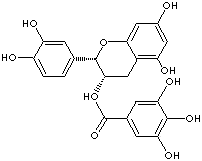PRODUCT IDENTIFICATION

C22H18O11
H.S. CODE
TOXICITY
CLASSIFICATION
EGCG; Tea catechin;
(2R,3R)-2-(3,4,5-Trihydroxyphenyl)-3,4- dihydro -1(2H)- benzopyran-3,5,7- triol 3-(3,4,5- trihydroxy benzoate); 3,4-Dihydro-5,7-dihydroxy- 2R-(3,4,5- trihydroxyphenyl)-2H-1- benzopyran-3R-yl- 3,4,5- trihydroxy-benzoate;
PHYSICAL AND CHEMICAL PROPERTIES
AUTOIGNITION
NFPA RATINGS
REFRACTIVE INDEX
Stable under ordinary conditions. Hygroscopic, light sensitive.
APPLICATIONS
APPEARANCE
ASSAY
GENERAL DESCRIPTION OF FLAVONOID
- Flavonols (Hydroxy derivatives of flavone): Fisetin, Galangin, Kaempferide, Kaempferol, Morin, Myricetin, Myricitrin, Quercetin, Quercetrin, Rhamnetin, Robinin, Rutin, Spirenoside
- Flavones (skeleton: 2-phenylchromen-4-one): Apigenin, Baicalein, Chrysin, Diosmetin, Diosmin, Flavone, Luteolin, Rpoifolin,Tangeretin, Techtochrysin, Rhamnazin, Nobiletin, Natsudaidain.
- Isoflavones (skeleton: 3-phenylchromen-4-one): Daidzin, Genistein, Irilone, Luteone, Prunetin, Pratensein,
- Flavonones (derivation by reduction of the 2(3) C=C bond): Eriodictyol, Hesperidin, Hesperetin, Likvirtin, Naringin; Naringenin; Pinocembrin
- Flavanols (derivation by reduction of the keto group):(+)-Catechin, (+)-Gallocatechin, (-)-Epicatechin (EC), (-)-Epigallocatechin (EGC), (-)-Epicatechin 3-gallate (ECG), (-)-Epigallocatechin 3-gallate (EGCG), Theaflavin, Theaflavin 3-gallate, Theaflavin 3'-gallate, Theaflavin 3,3' digallate, Thearubigins
- Anthocyanidins (aglycones of the glycoside anthocyanins): Apigeninidin, Cyanidin, Delphinidin, Diosmetinidin, Guibourtinidin, Fisetinidin, Luteolinidin, Malvidin, Pelargonidin, Peonidin, Robinetinidin, Tricetinidin, Capensinidin, Petunidin, Europinidin, Aurentinidin, Columnidin, 5-Desoxy-malvidin, 5-Desoxy-peonidin, Hirsutinidin, Rosinidin
PRICE
INFORMATION